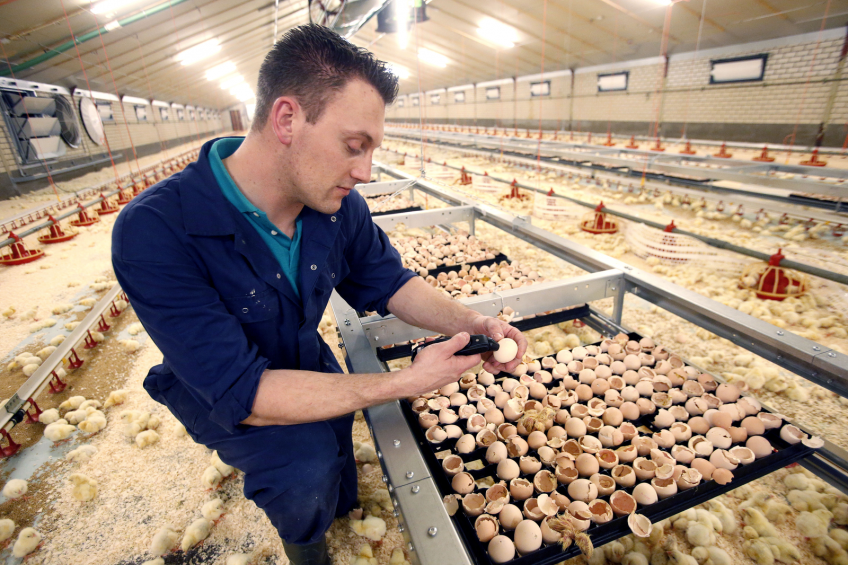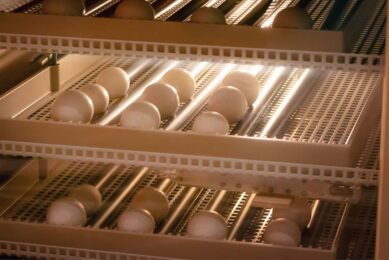Hatching of chicks on the broiler farm

A new, revolutionary way of working in the broiler industry: purchasing ?incubated eggs, the chicks hatch in the house and have direct access to water and food. Vencomatic has ten broiler farmers in the Netherlands and Belgium who work with the X-Treck system.
The past two years, there have been many experiences concerning the hatching of chicks on-site. In the current system, the first chicks at the broiler farm are 48 hours old before they have had the chance to imbibe any food or water. This method puts the strongest chicks, those who hatch first, behind schedule. The first four days chicks are not capable of regulating their own body temperature. Proper growth and development are dependent on the climate that poultry farmers regulate. The perfect combination of air and soil temperature, airspeed and humidity should lead to better quality and less failure among chicks. Fons Romme: “The X-Treck is a unique concept that enables on-farm hatching in traditional houses. Setter trays with 18-day pre-incubated eggs are placed on a rail system suspended over the length of the house. The rail system is suspended in such a way that, during hatching, there is an optimal movement of air around the eggs. The broiler farmer can adjust the height of the system using a winch so they have complete control over the movement of air and temperature around the embryo.”
Sharing experiences
At the proverbial kitchen table, we share our experiences with several experts: Cees Horrevorts, from Van Hulst hatcheries, veterinarian Gerwin Bouwhuis (health care centre for poultry in Emmen), Harm Prins and Klaas-Jan Krijgsheld, who specialise in broilers at De Hoop, and Fons Romme, sales advisor at Vencomatic. All agree that hatching chicks in the house is a new revolution and a system for the future. Cees Horrevorts: “Belgabroed has 600,000 chicks in Belgium and has a house with X-Treck. We breed small hatching eggs for our own companies. Those results are harder to compare. We see that the chicks are calmer and the look of it is friendlier. It is certain that hatching in the house gives new dimensions to keeping chicks.” Fons: “The X-Treck system is suitable for every house, regardless of the type of heating system. It is important to bring the eggs to the correct height. In practice, we see that companies will simply start a house and see what happens from there.” In a traditional set-up, chicks are immediately preoccupied with their search for food and water. This is what is so striking about the X-Treck system; the chicks are calm, do not run around as much and make less noise. Once in the house, all the chicks start searching for food and water at the same time. Harm Prins: “In practice, we see that chicks who hatch in the house are more vigorous and easier to manage, which in turn yields a better conversion of food.” Klaas-Jan adds: “The chicks are less stressed out because they haven’t been on a transport and there is less cross-contamination.” Fons Romme: “In practice, a system that can hold 35,000 chicks can be cleaned in an hour during vacancy. After the chicks are hatched, the system is cleaned using a leaf blower.”
Suitable for whom
The hatching of chicks on the broiler farm requires a great deal of involvement from the broiler farmer, according to all experienced experts. He or she should understand the importance of a good start and give this start enough time and attention. Klaas-Jan: “It’s not like we can just hang an X-Treck in the house and solve all our problems in an instant.” Fons: “Everything has to be optimised; then you can earn back the cost of the system within three to four years. X-Treck is used to make a good start, everything else is as usual. You have to gain your advantage from the better start.” Cees Horrevorts: “This system is not compatible with broiler farmers who are already very busy. The first three rounds are used to get accustomed before everything becomes automated. You have to see the challenge. It’s great to experience. You hear chirping, but don’t see a single chick. Exciting!” Fons Romme: “The companies are given intensive support. Every company and poultry farmer needs a different approach.” Klaas-Jan: “Often it’s small things; the place where temperature is measured on the egg, for example. On the air chamber this temperature is 2°C lower.” If the egg has the right temperature, everything will be alright. The broiler farmers receive a small suitcase from Vencomatic which includes an ear thermometer, anemometer and a manual with clear instructions, which will clarify various situations. Gerwin Bouwhuis adds: “Hatching in the house isn’t difficult. It just requires slightly different areas of concern.”
Animal health
If you are able to offer food and water to the chicks immediately, their organs will develop incredibly fast for the first two days. The chicks will have a good start, better technical results and a low use of antibiotics. The sooner the intestines come into contact with food, the better. A chick can survive just fine for several days using the yolk sac alone. The energy is then used to survive. Gerwin Bouwhuis: “If the chicks who hatched first go too long without food, this will influence their immune system in a negative way. The intestinal villi will break and bacteria from the intestines will enter the blood stream, which will result in infections. A disrupted immune system gives negative reactions to the hormonal system. For the health of the animal, hatching in the house is nothing but positive.”
Harm Prins: “The experience is that chicks will immediately start searching for water first and food second. The feed stays in the house, so it is hard to measure whether the chicks consume more food. This can be measured at Hatchbrood, where the chicks stay in the hatchery for the first few days.”
Better results
The first user day for broiler farmers using the X-Treck system took place recently. “Sharing experiences and learning from each other was the central focus. All broiler farmers using X-Treck also have a reference house, so we could compare a lot of data,” Fons Romme tells us. The broiler farmers indicate that the job satisfaction they experience is much higher when using X-Treck. The technical results are: 50 to 100 grams higher end weight, 0.5% less deaths, 4-5 points better food conversion, less use of medicine and less trouble with enterococci and coccidiosis. Gerwin Bouwhuis expects that a large number of broiler farmers will switch to hatching broilers in houses. “Broiler farmers are becoming more skilled and want greater control in the production process. I see advantages in hatching in the house. The things the chick experiences in the first few days, during the imprinting phase, it will carry with it for the rest of its life. However, we still need scientific proof of this.”
Vencomatic, Belgabroed / Van Hulst and the University of Wageningen are conducting joint research into what the possible explanations could be for the positive results, so broiler systems can become even more sustainable. The goal of this research is to gain greater insight into (possible) differences in animal health and welfare, and the technical performance between chicks that hatch at the broiler farm (X-Treck) and chicks that hatch at a hatchery. What factors in the early life of the broiler result in optimal animal health and animal welfare during the entire production period?
The answer to this question can lead to a large reduction in the intake of antibiotics and an improvement in product quality. “We see several advantages, but they have not yet been scientifically proven. Via this project, we hope to obtain this proof.” X-Treck gives an optimal start, resulting in robust broilers. Horrevorts: “A higher rate or return in the broiler business, less use of antibiotics and a better image. As a hatchery, we want to participate and cooperate in this. New developments should be embraced.”
Klaas-Jan: “Dutch society is asking for affordable and socially responsible production. The system innovations are aimed at the future and increase our social base of support. They contribute to achieving a better balance between man, animal and the environment.”
Join 31,000+ subscribers
Subscribe to our newsletter to stay updated about all the need-to-know content in the poultry sector, three times a week. Beheer
Beheer








 WP Admin
WP Admin  Bewerk bericht
Bewerk bericht